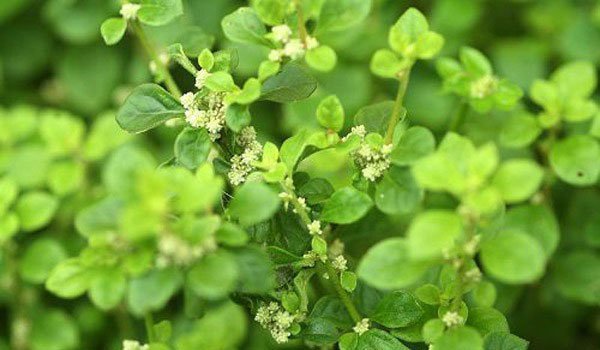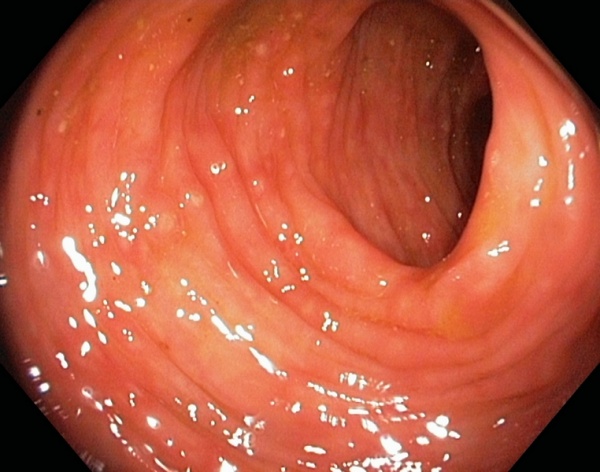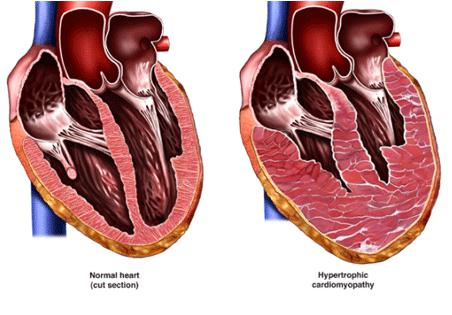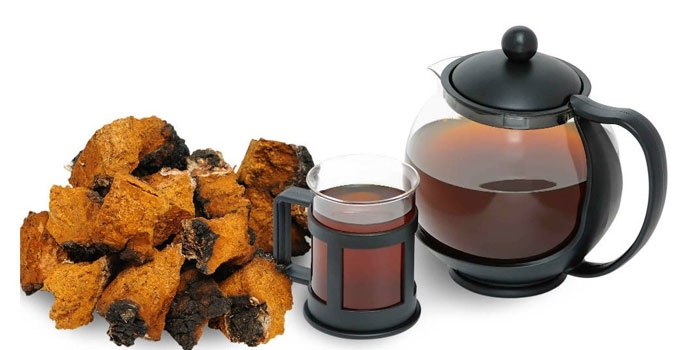Ingrown toenail on big toe
An ingrown toenail is not only an aesthetic problem, but also a serious medical condition. Without proper treatment, ingrown toenails can cause severe pain when walking, as well as other unpleasant consequences.
What it is?
An ingrown toenail is a serious medical condition known as onychocryptosis. Also, in some medical sources, this disease is called the incarnation of the nail plate. This is a fairly common pathology, which occurs with equal frequency in adult men and women, and in young children.
Onychocryptosis is a pathological change in the nail plate on the leg, which is accompanied by the ingrowth of its outer or inner edge into a certain area of \u200b\u200bthe nail fold. In the vast majority of cases, with onychocryptosis, the outer edge of the nail bed on the big toe is directly affected. In this case, the integrity of the periungual soft tissues is violated.
An ingrown toenail is accompanied by a pronounced inflammatory process. The affected nail fold acquires a rich red hue, becomes swollen. Any attempt to touch the nail bed is accompanied by soreness, which, without proper treatment, becomes more intense every day. The unpleasant consequences of a neglected form of an ingrown nail is the rapid development of swelling of the affected finger, which occurs against the background of an intense subcutaneous infectious and inflammatory process.
When talking about an ingrown toenail, in the vast majority of cases, the pathology of the big toe is meant. But this does not mean at all that the disease cannot affect the nail plates on other fingers. Absolutely any toe can fall into the so-called "risk zone".
The disease is accompanied by severe pain and severe discomfort, in some cases - severe purulent inflammation, infectious processes, as well as necrosis of the affected tissues.
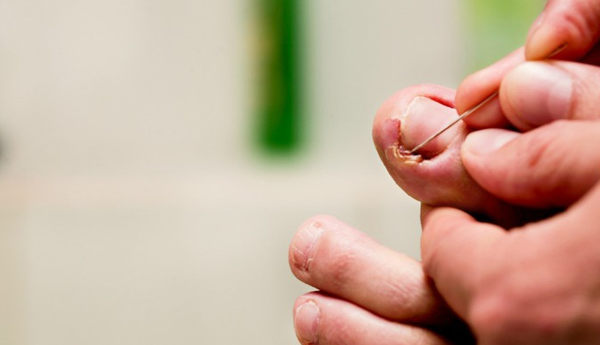
Treatment started in the early stages of treatment usually has the most positive results and allows you to completely restore the normal, healthy state of the nail plate. If the treatment was started out of time, then serious consequences cannot be avoided, and one of these consequences is the surgical amputation of the finger.
Causes
In order to avoid such an unpleasant phenomenon as an ingrown nail, you should have a clear idea of exactly what causes can provoke this pathology. The reasons for the appearance of an ingrown can be very diverse:
- One of the most common causes of ingrown toenails is improper trimming. An unsuccessful pedicure, just like careless handling of nail scissors - this is what in most cases causes the subsequent ingrown nail plate. During the pedicure procedure, carefully monitor how evenly you cut the edges of the nail plates. And be sure to carefully file the edges with a nail file - this will prevent their possible ingrowth. You should try to cut your nails only in a straight line, carefully avoiding any cuts but oblique.
- An equally common cause of ingrown toenails is wearing shoes that are too narrow and tight. This problem is familiar to almost every second representative of the fair sex - very often girls buy charming shoes 1-2 sizes smaller just because they really liked them. Systematic pressure on the toes and nail plates provokes their deformation and a change in the direction of their growth.
- Very often, the ingrown nail plate can be caused by various diseases of the internal organs - for example, diabetes mellitus, circulatory pathologies, any diseases accompanied by changes in the orthopedic shape of the foot.
- Fungal infection - often leads to a pathological growth of several layers of the nail plate, as a result of which the nail acquires an ugly yellow tint, becomes thickened and rough. A fungus can cause an ingrown toenail.
- Any mechanical injury and damage to the toes can cause ingrown nail plates.
- An important factor in the development of onychocryptosis is heredity. If parents, grandparents have had cases of ingrown nail plates, the risk of developing onychocryptosis in children is extremely high.

Folk remedies
Treatment of an ingrown nail can be carried out at home, as well as in a hospital setting. In the event that the treatment of onychocryptosis is carried out at the initial stage of the disease, you can use a variety of medicinal herbs and other home remedies that are no less effective than pharmacological drugs. So, how to treat this disease with folk remedies:
- Washing your feet in a solution of potassium permanganate is an effective remedy for dealing with ingrown nails. Pour a little potassium permanganate into hot water, steam your leg and wrap the affected finger with a freshly picked plantain leaf. Put on a warm sock on top and leave the plantain leaf until the morning. Before wrapping your finger with a plantain leaf, it is best to lightly beat off the plant with a hammer - so that a little juice appears on its surface. Potassium permanganate can easily be replaced with 1-2 tablets of furacillin, 2-3 tablespoons of soda or salt. The effectiveness of the treatment will not suffer from this.
- An excellent effect also has a decoction of chamomile or St. John's wort, which can be used in the initial stages of ingrown nail plate. Dissolve 6-7 tablespoons of a medicinal plant - chamomile or St. John's wort in 2 liters of hot water, then bring the broth to a boil and leave it to brew for 1.5 hours. Then heat the broth back to room temperature and steam your feet for half an hour. After the nail plates are sufficiently steamed, give them the correct shape with nail scissors.
- Every evening, immediately before going to bed, soak the affected finger in a warm solution of potassium permanganate or medicinal herbs. After that, cut off a small piece of clean gauze, put a cube of butter in it and wrap it around the affected finger. Top with a warm sock. Creamy compresses help eliminate pain and soften the nail plate, as a result of which it can be given an anatomically correct shape.
- Vishnevsky's ointment also has an excellent softening effect. Put a sufficient amount of ointment on a sterile gauze or bandage, then wrap it around the sore finger and leave until the morning. As a rule, 3-5 procedures are enough for the nail plate to soften, and it can be painlessly corrected.
- Tear off one large leaf of aloe, grind it with a meat grinder, add a teaspoon of olive oil to the resulting gruel. Put the resulting mixture on a clean piece of bandage or gauze and wrap it around a sore finger, leave the compress until the morning. 3-4 procedures are enough to completely get rid of such an unpleasant problem as an ingrown toenail on the big toe.
- An effective medicine that can be prepared at home is an ointment. To prepare it, mix one tablespoon of pre-chopped garlic, onion, aloe, natural honey and butter. Mix all components thoroughly and apply on the affected nail plate, warm the compress on top with several layers of gauze and plastic wrap.
- In a glass or ceramic container, mix 1 tablespoon of sea buckthorn oil with a teaspoon of Dimexide, mix everything thoroughly and apply on the affected toe. Wrap with plastic wrap on top and leave until morning. Such procedures allow you to eliminate suppuration and inflammation in the affected areas of the body, restore the normal state of the nail plates.
Removal
In the event that alternative methods of treating an ingrown toenail did not bring the expected result, or it was started in the later stages of the disease, the use of surgical methods of treatment is recommended.
Ingrown toenail laser treatment is an innovative and completely painless procedure that allows you to remove directly affected areas of the nail plate without affecting healthy ones. The laser acts pointwise, allowing you to effectively evaporate and cauterize soft tissues. The whole procedure takes no more than 15-20 minutes and is performed using local anesthesia. As a rule, after laser treatment of an ingrown nail, the probability of a recurrence of the disease is no more than 1-2%.
In the process of laser treatment of ingrown nails, healthy areas of the nail plates and skin are not affected, and this is an undoubted advantage of this treatment method.
In addition, the removal of an ingrown toenail leaves no marks, scars or scars. Its undoubted disadvantages include, perhaps, only a fairly high cost of the procedure.
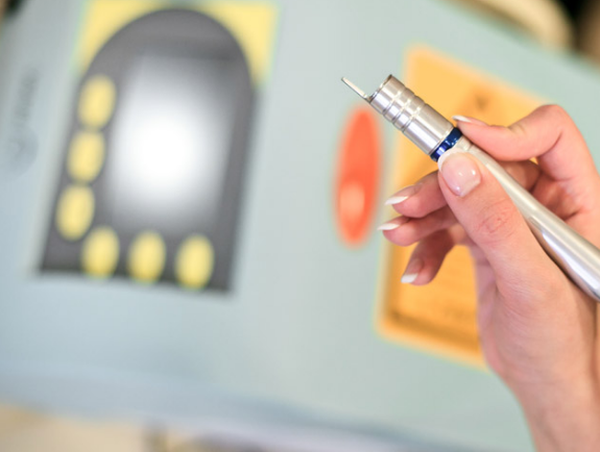
Conservative medical therapy involves the use of special splints that protect the nail bed directly from the touch of the nail plate.
In the most neglected cases, when there is a need for prompt removal of a growth of new skin, which inhibits the healing of the wound and the growth of the nail plate, the surgeon performs excision of excess tissue and affected areas of the nail plate. The surgical method of treatment is recommended to be used in the case when there is suppuration of the tissues. The doctor can fully clean all tissues and remove the slightest remnants of purulent accumulations.
Before the operation, it is recommended to undergo a complete x-ray examination of the lower limb, which helps to determine the exact degree of damage to the lower limb. The main difference between traditional surgical treatment and laser is that in the course of a conventional operation, the entire nail plate is most often removed. When using a laser, it is possible to achieve a cure by removing only part of the affected nail plate.
The main problem of surgical treatment of an ingrown nail is that during the operation, as a rule, the growth zone of the nail plate is damaged. As a result, in the process of regrowth, a new nail plate can also acquire an irregular geometric shape. And, accordingly, there is a risk of relapse.
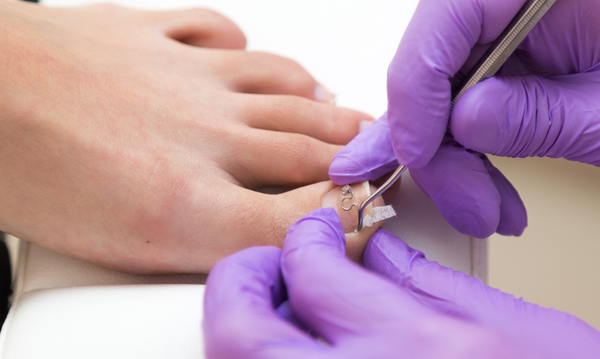
How can I prevent future ingrown toenails?
In order to protect yourself from ingrown nails, care should be taken to completely eliminate all causes that can provoke the development of pathology.
Completely eliminate tight and narrow shoes from your life. Try to give your preference only to shoes with a wide enough toe that does not squeeze your toes and allows blood to circulate normally in the lower extremities.
The cause of the appearance of trouble is an incorrectly done pedicure. Therefore, we recommend that you read the article about special, fashionable today.
Make sure to trim and file your toenails at least once a week. No original shapes or oblique cuts - only cutting the nail plate in a straight line can guarantee its health and integrity.
In the bath, swimming pool, water parks and other public places, be sure to wear disposable rubber shoes. It will reliably protect your feet from a fungal infection and prevent the occurrence of an ingrown toenail.
Warm foot baths should be not only an effective treatment, but also an effective prevention. Soak your feet 2-3 times a week in warm water with the addition of sea salt, soda, natural honey or medicinal herbs - and you will never be bothered by the problem of ingrown nails.
- Intercostal neuralgia - what is it and how to treat
- How to quickly get rid of dry corns on the legs
- How to treat left ventricular hypertrophy
- Rating of the best drugs for rotavirus for children
- Making tea from currant leaves, the benefits and harms of the drink
- How to drink hydrogen peroxide according to Neumyvakin - an oral regimen
- Features of the treatment of plantar fasciitis with folk remedies
- The composition and beneficial properties of parsley root
- How to get pregnant quickly? Folk remedies
- Herbs-ants in the "pot-bellied" period or the use of herbal medicine during pregnancy
- Why does a sore throat and dry cough occur, and what treatment is required?
- Guy's Room Design: Ideas and Examples
- General rules for drawing up a foundation plan House foundation drawings
- modern art deco bedroom small art deco bedroom
- Pansies: characteristics and photos of flowers
- Making an art deco bedroom: the choice of materials Beige art deco bedroom
- Bedroom interiors in art deco style Bedroom art deco style beige
- Young: planting and care in the open field Young planting and care in the open
- Varieties for open ground
- Pansies: cultivation and care in the open field




